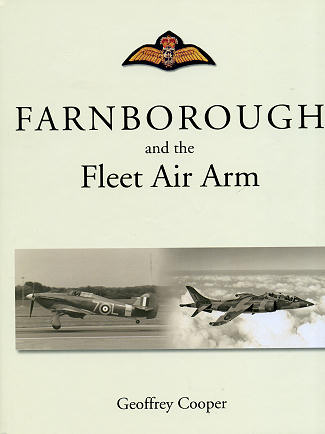 Midland
describes this edition as a companion to the author's earlier book on
Farnborough, but this time, it concentrates on the programs of the Fleet Air Arm
vice the RAF as in the earlier volume. Also like the earlier volume, it starts
at the earliest days of aviation and continues right up to the present, though
FAA testing is no longer performed at Farnborough, but at RAE Bedford.
Midland
describes this edition as a companion to the author's earlier book on
Farnborough, but this time, it concentrates on the programs of the Fleet Air Arm
vice the RAF as in the earlier volume. Also like the earlier volume, it starts
at the earliest days of aviation and continues right up to the present, though
FAA testing is no longer performed at Farnborough, but at RAE Bedford.
It is a surprise to those newly introduced to the subject of
naval aviation, just how many innovations were a result of FAA requirements. The
use of tail hooks, the catapult (both open and tracked), and the carrier landing
fresnel lens system are just a few of the items originally developed by the
British. Though many of these were adapted or improved to meet US and other
nation's requirements, the main work was pretty well British.
The book is extremely detailed when it comes to the various
sections. This is not your average large print, light reading volume and as
such, requires a rather high level of interest in the subject. It starts around
WWI as interest in aviation and how it can be adapted to ships gets underway.
First with simple ramps for take-off and later as the thought of assisted launch
gains headway. There is a great deal of space provided in the book on the
development of ship board catapult systems, with the British using a
considerable variety of designs. Each are covered in some detail.
Then, of course, comes work into getting the plane back
on board and it is realized that this takes a bit more room. Various early
designs are discussed until the now standard tail hook and arresting wire system
is developed. As there is more to arresting gear than just a cable, a look at
this important aspect of naval aviation is also fully discussed. Along with this
is the development of crash barriers for those who happen to miss all those
wires or have equipment failure. The book also covers what the British call
accelerators, which are what most call catapults, those devices built within the
decks of aircraft carriers to launch planes into the air. Along with this are
the various bits and pieces needed to attach to aircraft to not only get them
airborne, but also to hold them back until the proper launch parameters have
been met.
To improve gunnery skills against incoming aircraft, there
was interest in pilotless aircraft, mostly for use as drone targets and that is
also covered in some detail as well. The navalization of a number of aircraft
types is discussed along these lines as well.
All through this the facilities at Farnborough are built and
developed to meet the changing needs of the services. The author uses a superb
collection of period photographs of not only the facilities, but also of the men
who ran them and the projects that were underway at different times of the FAA's
use of the sites.
This all makes for a most imposing volume that is absolutely
jam packed with information and the fascinating development of these various
systems. As I mentioned, it is not light reading but an in-depth look at what
makes naval aviation possible today.
March 2009
Review book courtesy of
Specialty Press
 ,
where you can order your copy of this and many other superb aviation and
modeling books. Visit their website at the link above or call them at
1-800-895-4585
,
where you can order your copy of this and many other superb aviation and
modeling books. Visit their website at the link above or call them at
1-800-895-4585
If you would like your product reviewed fairly and quickly, please contact
me or see other details in the Note to
Contributors.
 Midland
describes this edition as a companion to the author's earlier book on
Farnborough, but this time, it concentrates on the programs of the Fleet Air Arm
vice the RAF as in the earlier volume. Also like the earlier volume, it starts
at the earliest days of aviation and continues right up to the present, though
FAA testing is no longer performed at Farnborough, but at RAE Bedford.
Midland
describes this edition as a companion to the author's earlier book on
Farnborough, but this time, it concentrates on the programs of the Fleet Air Arm
vice the RAF as in the earlier volume. Also like the earlier volume, it starts
at the earliest days of aviation and continues right up to the present, though
FAA testing is no longer performed at Farnborough, but at RAE Bedford.